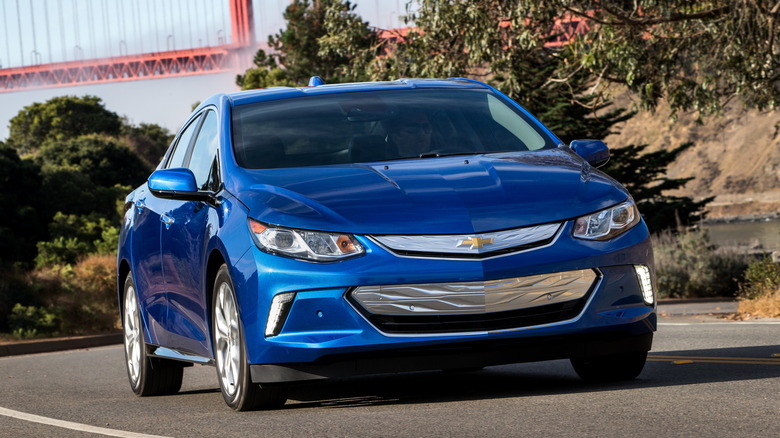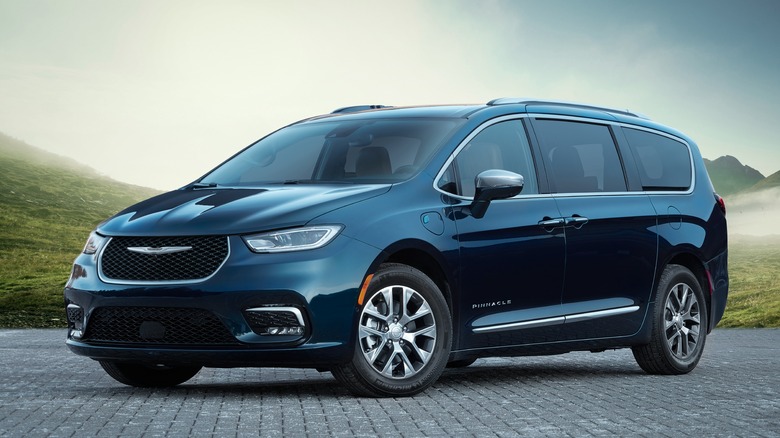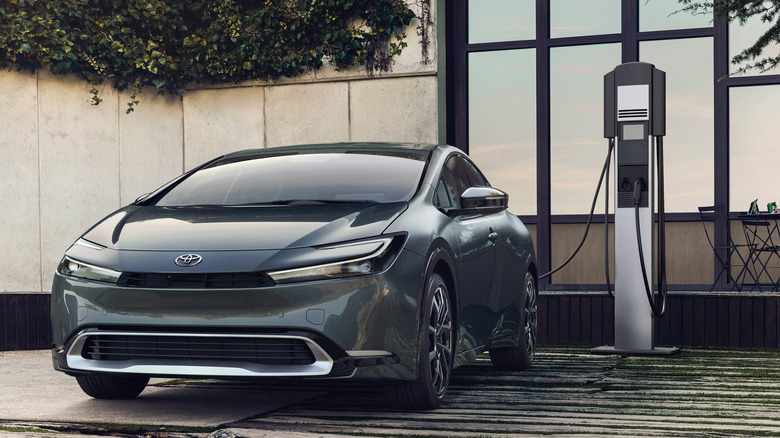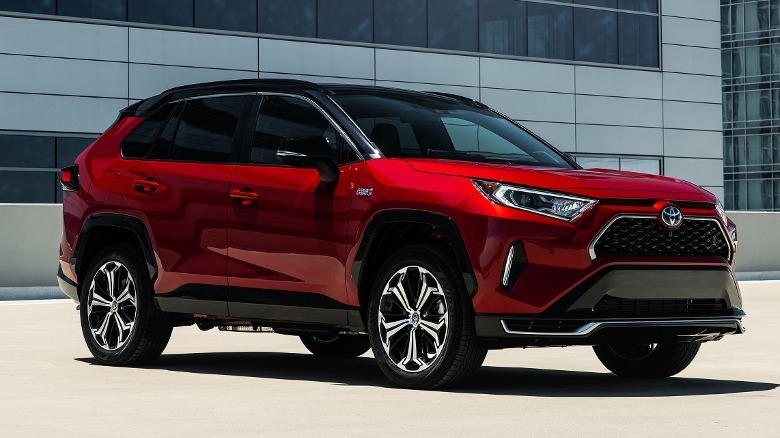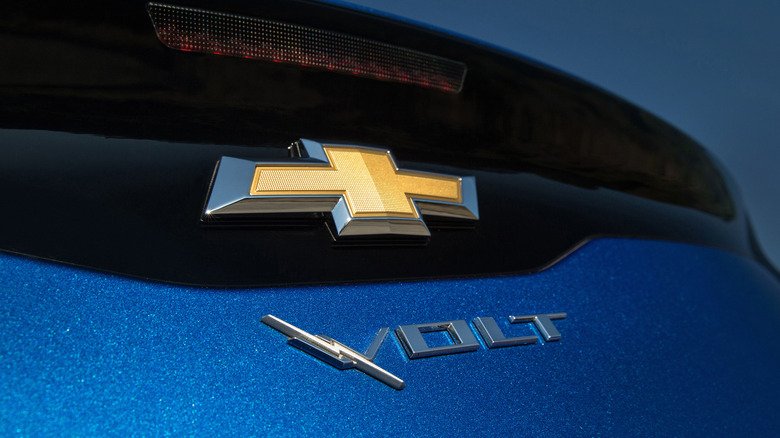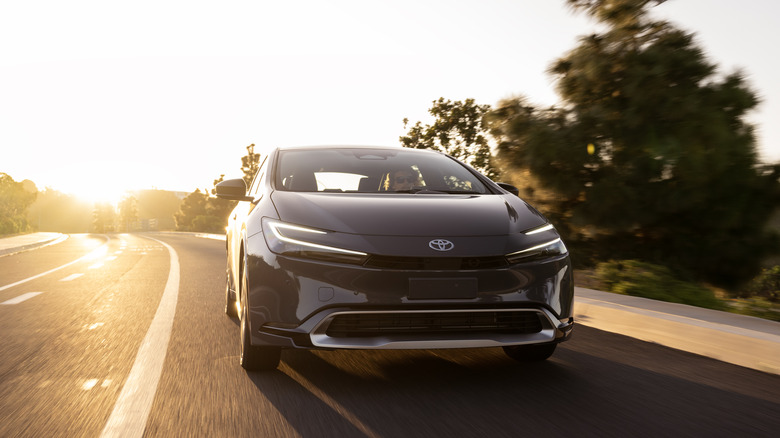Why PHEVs Could Be The Smartest Car Choice You're Not Making
Plug-in hybrid electric vehicles (PHEVs), while not necessarily maligned, have been shoved into a category they just don't fit in. Almost since the first models arrived, they've been pitched as a transitionary device between a gas-powered car and an electric vehicle. And — while the appeal of that is clear — it's also an unfair characterization, because a PHEV is really its own class of vehicle using innovative technology to lower emissions. It's not a temporary stop-gap between driving a huge V8 pickup and buying a Tesla. Although it may serve as a vehicle to get a driver ready for a pure-EV lifestyle, that's doing a disservice to the segment entirely.
There are three different kinds of vehicle that call themselves hybrids on the market right now. There's the "mild hybrid" technology found in many SUVs and trucks, that utilize an electric motor to assist starting the engine and braking. Such systems usually use a 48-volt battery. Regular "hybrids" — also called "parallel hybrids" — use both a gas engine and at least one electric motor in tandem to drive, with power to the electric motors coming from a battery. These batteries recharge typically through regenerative braking.
Finally, there are "plug-in hybrids" or PHEVs. These have an electric motor powering the wheels and a battery, like a full EV, but also a gasoline motor acting as a generator of sorts to keep the battery topped up and supplying energy to the motors.
Automakers have gone all or nothing
Arguably the whole point of switching to EVs in the first place was to reduce emissions and lessen the environmental impact that gasoline-powered cars have. PHEVs are absolutely a step in the right direction, but as of now, it seems to be an "all or nothing" attitude among many automakers. You have a choice of a full-EV or you can buy a large gas-powered crossover SUV. There is no in-between.
Automakers, instead of looking at what consumers actually want to buy, are pushing PHEVs aside to transition product lineups into fully electric models. When really, the goal should be reducing the number of miles driven in gasoline-powered cars. Customers aren't going to buy EVs if their lifestyle or living situation doesn't support one for the sole purpose of helping out a major automaker meet its sustainability and environmental goal, even if said goals are admirable.
Already, many automakers have pledged to make their respective lineups 100% electric. Volvo says it can do it by 2030. Lotus (owned by Geely, the same company that owns Volvo), thinks it can go fully electric by 2028. If customers aren't ready to adopt an EV lifestyle by then, Volvo may well lose loyal customers.
PHEVs, on the other hand, can work with existing infrastructure that drivers are already used to, while also increasing the number of no-emissions miles driven.
PHEVs can be fun
PHEVs deserve to be treated as a separate class of vehicles and not pigeonholed into something the segment isn't, and dismissing them as halfway measures toward full electrification ignores the fact that there are other reasons gas and electricity work well together. Take, for example, the newest 2024 Jeep Wrangler. In its plug-in configuration, the Wrangler 4xe, it doesn't actually get much getter fuel economy, averaging around one mile per gallon better than its gasoline powered brethren. However, it offers something that the gas model doesn't that helps its environmental impact and doesn't diminish any of its inherent "Jeep-ness."
That is, the ability to drive without using gas. The 2024 Wrangler 4xe can go for about 20 miles using only the battery to drive the wheels. For a vehicle that can barely achieve 20 miles per gallon on a good day, being able to run short errands drive to the other side of town is huge not only for sheer convenience, but eliminating emissions that would have occurred as a result of idling at stop lights or milling around a parking lot. Plus, to keep the enthusiasts happy, the integrated electric motor offers gobs of instant torque for all the Jeep-ness you could ever want. Aside from the premium in price, you aren't really sacrificing anything going to a PHEV Jeep.
Or, for a purely practical take, Chrysler offers a PHEV version of the Pacifica. It can go 30 miles on a charge and, when the gasoline engine kicks in, that range can be extended to upwards of 500 miles between tedious fill-ups at the gas station.
Toyota's prime movers
The same can be said for the commuter crowd with the 2023 Toyota Prius Prime or RAV4 Prime. You aren't "missing out" on anything by taking the PHEV route. You get all the convenience and infrastructure backbone of a gasoline powered car, and the added environmental and money-saving benefit of the ability to switch to an all-electric mode for short distances. The Prius Prime can get upwards of 44 miles of range before running out of electrons, and the RAV4 Prime can get 42 miles.
Even without driving in EV mode, you get way above average fuel economy. Plus, it's a Prius and a RAV4: you aren't going to be taking much of a "leap of faith" trusting Toyota to make a car that runs reliably and comfortably. The term "no compromises" usually refers to outlandish supercars or off-road monsters. But it takes a more literal meaning with PHEVs: there really are no compromises made.
Chevy's under appreciated Volt
Maybe it would be different if fully electric cars were plentiful, cheap, and enjoyed a surfeit of places to charge. We're not there yet. Take, for example, General Motors: it's going all in on Ultium, its EV platform, and things aren't going fantastically as far as vehicle choice is concerned. However, there was a time when GM was genuinely ahead of the pack when it came to making vehicles that cut down on carbon emissions and weren't miserable to drive.
That was the Chevy Volt, all the way back in 2011. Even now, the specs are pretty impressive; over a decade ago, it was practically from another planet. The 2011 Volt had an EV range of 30 miles and that was upgraded to over 50 as the years went on, not to mention you could get over 400 miles on a tank of gas.
As is arguably par for the course for General Motors, the Volt died before it could make any meaningful type of splash in the greater automotive consciousness and pure EVs became the popular "cars of the future." 2019 was the final year for the Volt. Even though GM gave up on making its PHEV, or even attempting to upgrade it in any meaningful way over the course of its production life, it proved a very important point: EVs are not a magic bullet to more environmentally friendly cars. There's more than one path to the same goal.
The future isn't electric, yet
GM's treatment of the Volt can hold partial blame to the treatment PHEVs have received. Chevy treated the Volt like a "missing" link of sorts between a regular gas-powered car and something like a Chevy Bolt. It didn't let the Volt breathe and evolve as its own type of car. Given issues with very high starting prices and the generally poor state of charging infrastructure, the automotive world is still likely several years from adopting a 100% electric fleet.
As it stands, many people can't even own EVs in the first place due to lack of ability to charge them: that might be because they live in an apartment without a dedicated parking space, or because their house doesn't have service rated for the high amperage draw of charging an EV.
PHEVs on the other hand, don't have the same shortcomings as a fully electric vehicle or the associated charging anxiety, because you've still got a gasoline engine, albeit one that's offloading a lot of the work to electric motors. Plus, it doesn't have the same environmental impact as a gasoline car when you drive short distances. There are no perfect cars for commuters, but PHEVs are very compelling, and essentially a win-win for the environmentally conscious facing the realities of electrification as it stands today.
